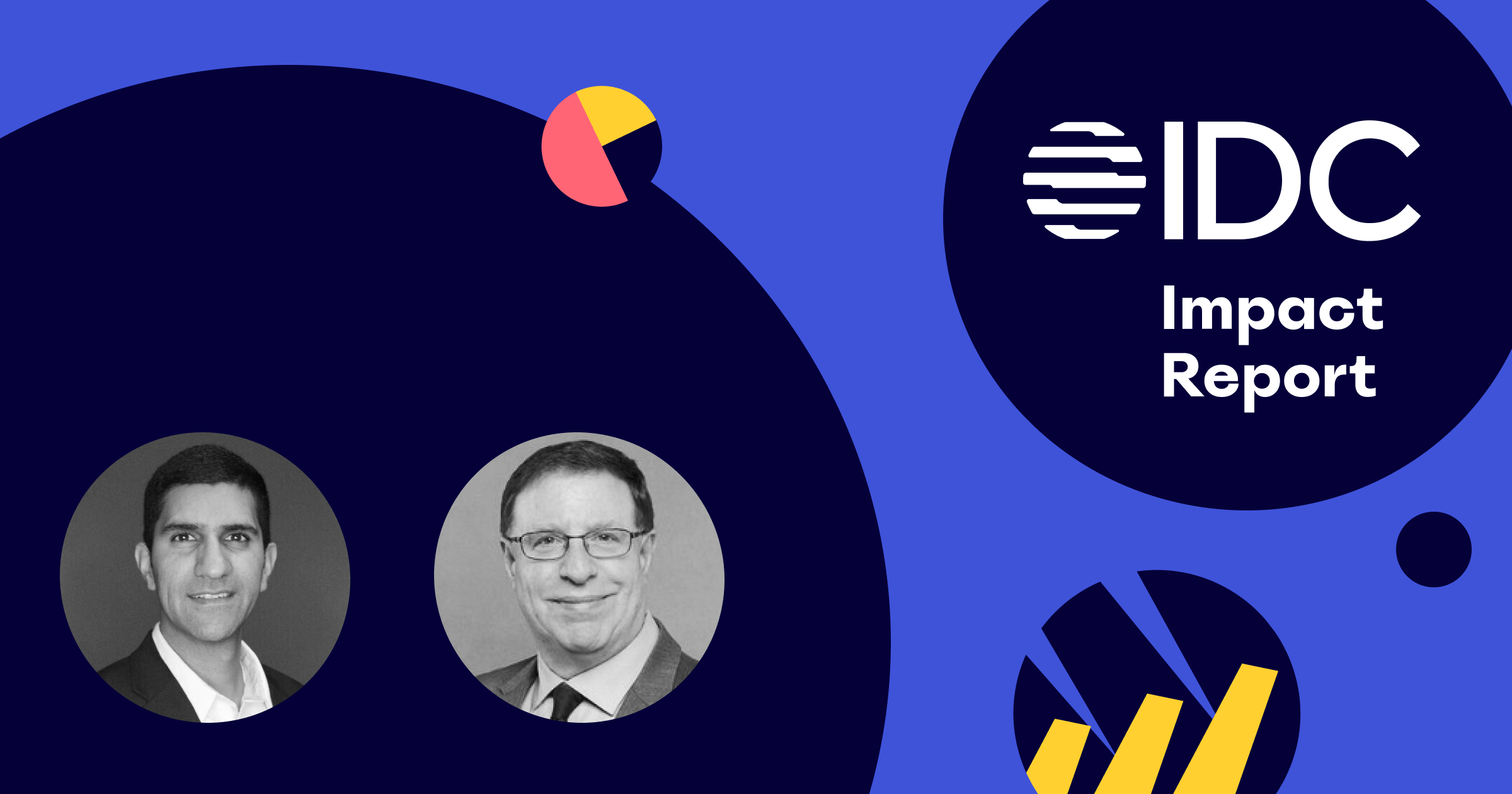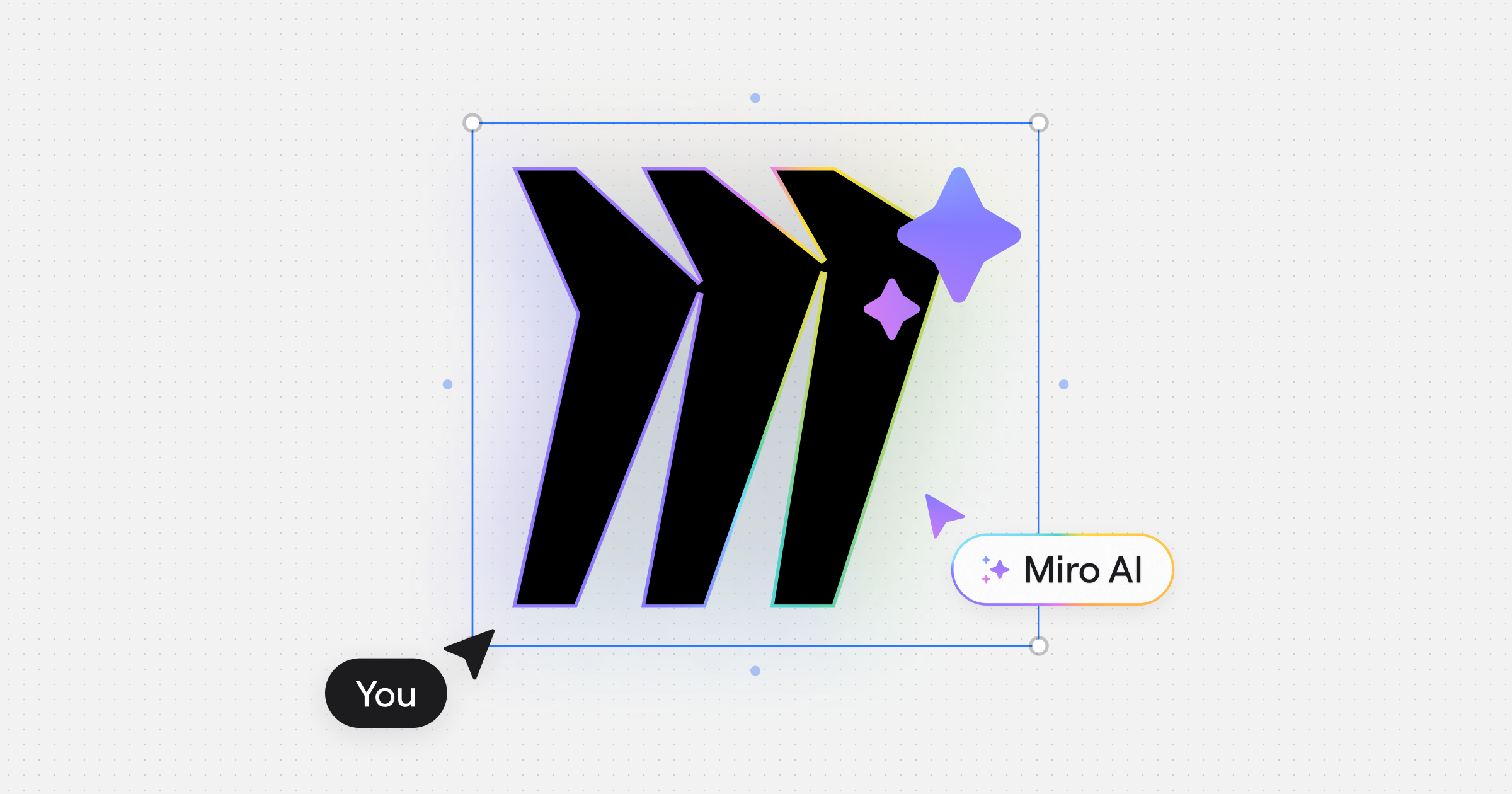This year, organizations will spend trillions of dollars to bring innovative products to market. However, most leaders are dissatisfied with current ways of working and their company’s ability to support such innovation. Adopting tools that help teams align against strategy, deliver on customer needs, and engage workers will be critical to competing in the modern market.
Miro recently hosted Wayne Kurtzman, Research VP – Social, Communities, and Collaboration at IDC in discussion with Varun Parmar, Head of Product at Miro during a webinar on the power of visual collaboration. Wayne shared some key insights on how work is changing and in what areas companies will need to invest to drive business forward.
Companies needed to build trust and mitigate risk with a collaborative tech stack and collaborative culture to create more engaged and empowered teams. The confluence of tech and culture is key: collaboration is inherently human. IDC defines it as the “interpersonal actions that create value from interacting around shared goals.” Collaboration requires both adopting supportive tools and embracing certain behaviors. IDC explains that companies need to implement layered strategies to drive trust, security, governance, and compliance to achieve success in the era of digital business.*
Watch the webinar with IDC & Miro
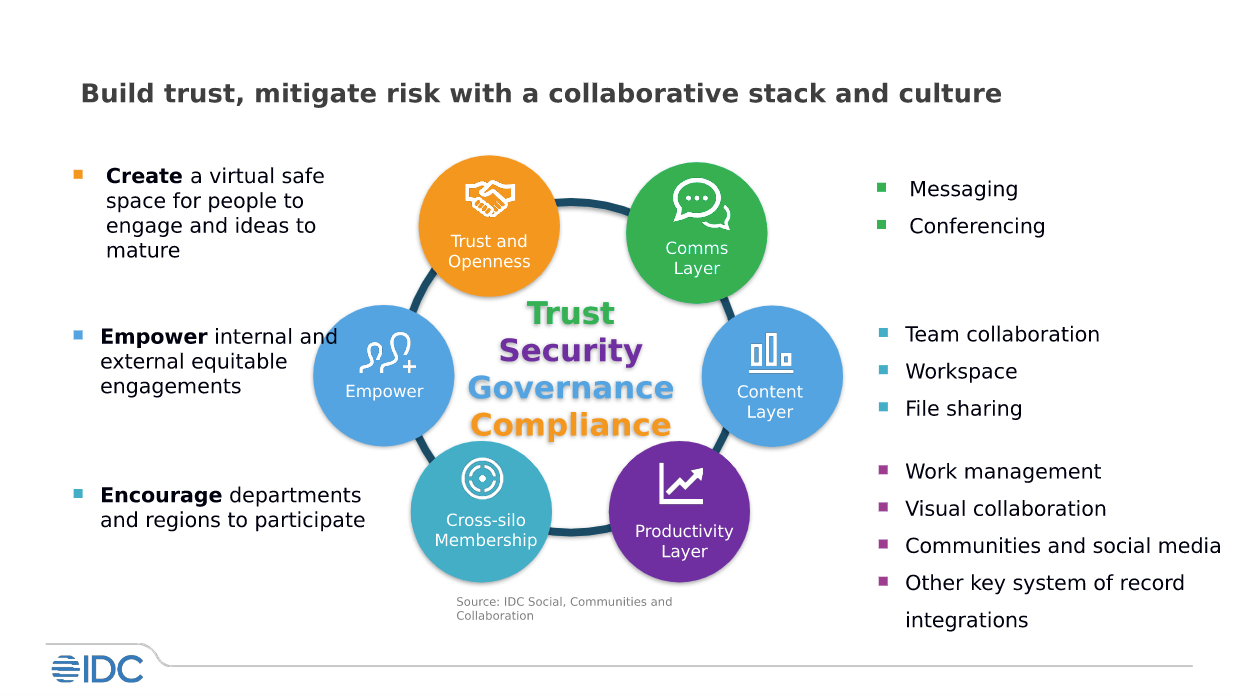
The missing layer in your tech stack: visual collaboration
Most companies have already mastered their communication layer. This includes solutions for messaging or video conferencing, like Slack and Zoom. These technologies allow teams to have conversations from anywhere at any time. Then there’s the content layer, which includes shared documents and file sharing such as Google Suite and Dropbox. These tools allow users to simultaneously work off of the same “sheet of paper” and share work across physical locations from the cloud.
IDC has identified the productivity layer as the “secret sauce” that is crucial for hybrid working.* This (often missing) piece of the puzzle supports complex task management, visual collaboration, building communities, and integrating with other key systems of record. Without it, they will be unable to empower truly equitable, efficient, and effective collaboration to power innovation.
The symbiotic relationship between technology and culture
Achieving true collaboration is impossible without implementing and supporting the right interpersonal behaviors. Cross-silo membership encourages different teams and regions to participate. Doing so not only saves time, but also can help prevent misalignment that may cause major issues with customer satisfaction. It is also important to empower team members by giving them the right tools to have both internal and external engagements that are actually equitable. By enabling teams to be more inclusive of all types of stakeholders, companies can build credibility and ensure the right voices are in the room to support key decisions. And finally, building trust and openness is critical to encouraging diversity of thought and driving innovation. This can only be accomplished when a company creates safe spaces for different opinions and perspectives.
We are now listening to voices that maybe weren’t at the table before but should have been. Inclusivity helps save time and builds credibility for the enterprise.
Wayne Kurtzman, Research VP – Social, Communities, and Collaboration at IDC
Truly, tools and behaviors have a symbiotic relationship. The right collaboration tool will not only support productive meetings and streamline complex workflows, but will also be an innovation platform that brings together distributed teams, powers inclusive interaction, and creates psychological safety so that teams can do their best work.
Signals of success for companies embracing visual collaboration
Companies who embrace visual collaboration as part of their “collaboration stack” are experiencing a range of tangible benefits that impact their bottom line. As Wayne put it, “Yeah, a ‘collaboration stack.’ That’s a thing. And it’s an important thing – because it’s where everyone comes to work regardless of where they are.”
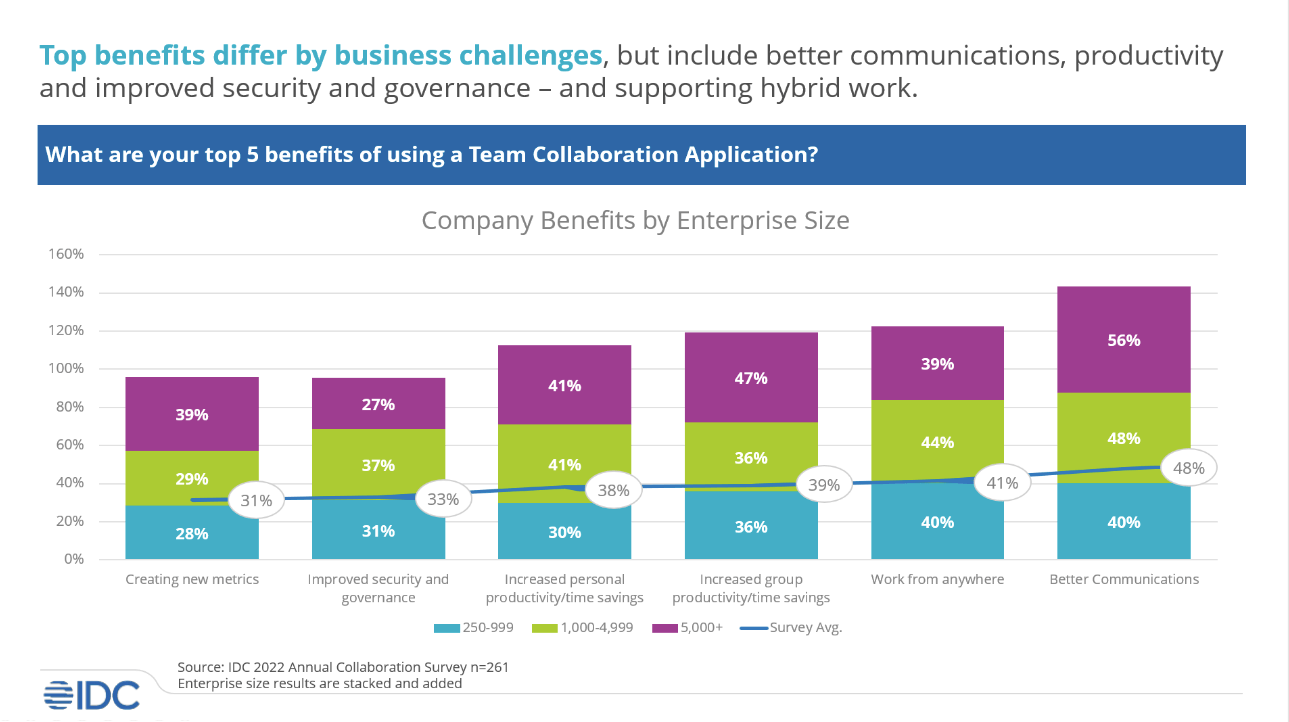
As shown in the above chart, enterprises from 250 to over 5,000 employees are creating new metrics, improving security and governance, increasing productivity and time savings, are able to effectively work from anywhere, and are experiencing better communication.
Companies are now basing success on metrics such as how well they can connect ideation through to bringing the right products to market. This is directly related to how well teams are aligning and engaging cross-functionally throughout the product lifecycle. Teams can also realize improved security and governance because when you implement a solid collaboration stack, users aren’t going rogue introducing other tools without IT approval. Integrations have been linked to increased productivity and saved time.
It is invaluable for teams to collaborate or do independent work in one online workspace instead of context switching between multiple tools. By creating a hub for all different applications to plug into, collaboration solutions create a more intuitive, enjoyable work experience.
Wayne Kurtzman, Research VP – Social, Communities, and Collaboration at IDC
Wayne Kurtzman, Research VP – Social, Communities, and Collaboration at IDC
How Miro delivers 349% ROI for enterprise customers
The Miro-sponsored IDC White Paper “Business Value of Miro” discussed in the webinar detailed the impact real customers are seeing from Miro, the leading visual collaboration platform. With 349% ROI over three years, 80 hours saved per year per user, and 15% increase in productivity, the results speak for themselves. Here are the ways customers are getting the most out of Miro’s innovation platform.
Improving productivity and saving time
Users across the world contribute to and take advantage of Miroverse, a collection of 700+ templates that unlock tremendous value. Creators from companies like Accenture, Dropbox, Salesforce, and TED help users crowdsource ideas and solutions. This helps teams get started fast with a built-in advantage – plus it allows them to standardize processes and avoid wasting time duplicating efforts.
showcasing new and innovative techniques from industry leaders.
With over 100 integrations and thousands of public and private apps, Miro integrates with your existing tech to maximize your investments, help reduce tool switching, and keep your teams in their flow – focused on the tasks at hand. This brings together disconnected teams and tools into one centralized platform, and creates a single pane of glass to see the big picture of your work. Over 50 partners including Google and Atlassian provide workflow-specific integrations that help connect teams and keep productivity flowing across any device, platform, or work style.
Boosting engagement and empowering connection
TalkTrack brings your board to life with recorded video walkthroughs and allows you to engage with collaborators asynchronously. The video is overlaid on top of a live Miro board so when people are watching the video they are actually inside the board itself and can interact with the board simultaneously.
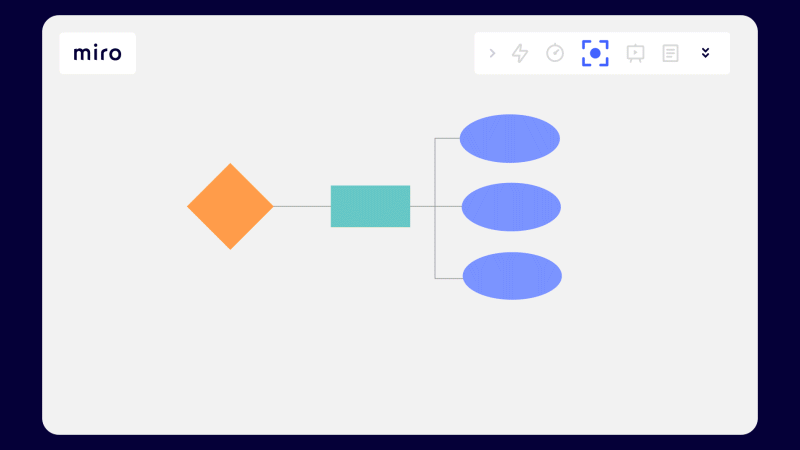
collaborators get up to speed asynchronously.
Knowledge workers are vulnerable to information overload, lack of clear guidance, and wasted time going back-and-forth on messaging platforms or email. Plus, not seeing each other leads to feelings of disconnection. That’s why more flexible ways of working like TalkTrack are important for enabling teams to connect, align, and collaborate outside meetings. Async communications give everyone a seat at the table, give remote workers better ways to communicate with teams, reduce the need for live meetings, and create more time for deep work.
For times when you need to meet live, it’s important to create a lively collaborative experience — that’s why we introduced Interactive Presentation Mode. This allows for audience interaction with reactions, hand raising, and sticky notes. Plus, presenters can seamlessly hand off presentation navigation controls to another presenter mid-meeting.
Driving revenue with cross-functional planning
While improving productivity and employee engagement are critical to driving overall revenue, it’s impossible to ignore the power of agile business strategy and planning. One of the findings highlighted in IDC’s findings explores how teams use Miro to more easily strategize on a quarterly or ongoing basis rather than being locked into a strategy at the start of the year.
Planning in Miro not only provides visibility across teams and levels of the organization, it also delivers a flexible shared digital workspace for iterating on and modifying plans to match the needs of the business at any given time.
*Wayne Kurtzman, “Business Value of Miro” Webinar, February 9, 2023

